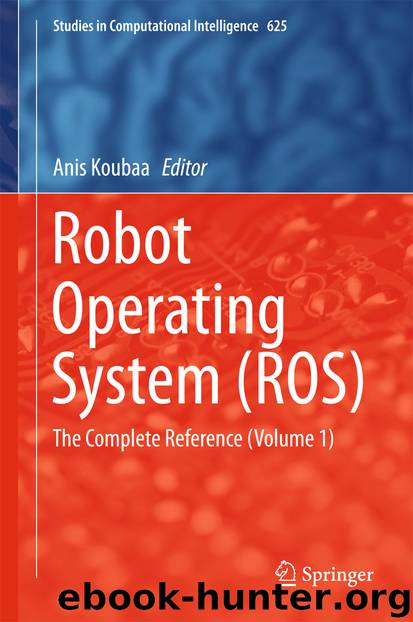Robot Operating System (ROS) by Anis Koubaa

Author:Anis Koubaa
Language: eng
Format: epub
Publisher: Springer International Publishing, Cham
Figure 11 shows an example of an affordance template for an ISS IVA handrail. Figure 11a shows a single handrail with R2 leg end effector waypoints, while Fig. 11b shows the same handrail with R2 arm end effector (hand) waypoints. The waypoints define locations to which the end effectors should move to ensure efficient grasping. The waypoints themselves can be relocated in real-time using their controls. In Fig. 11c, the handrail is shown in atop visualized data from R2’s depth sensor, which is represented as PointCloud data. This figure demonstrates how using a human-in-the-loop can handle perception inabilities that the robot may not be able to manage autonomously. The human can locate the handrail based on noisy data, and during real-time operations, move the template based on feedback from other sensors (i.e. cameras and image_pipeline data). This also allows for operations with imperfectly calibrated sensors. Also shown in this figure is the predicted path to the initial waypoint, as provided by the MoveIt! planner. The predicted locations are shown as a MarkerArray message type. Finally, Fig. 11d shows R2 using the handrail affordance template to grasp the actual handrail.
Currently, the affordance templates are being tested on the ground-based R2 for use with single manipulators. Waypoints for end effectors are used as the affordance definitions for template-related tasks. Tunable parameters currently available are scaling of the templates and the state of the end effector. Several features are planned in the near future. These include providing perceptual registration of a template to sensory data, so that initial placement of the template is decided by the robot itself; providing a plug-in component for planning of robot motion in relation to a template, specifically so that whole-body motions can be considered (MoveIt! does not currently support this); and adding force- and contact-based parameters to templates for managing compliance and stiffness of the robot during real-time task execution.
Download
This site does not store any files on its server. We only index and link to content provided by other sites. Please contact the content providers to delete copyright contents if any and email us, we'll remove relevant links or contents immediately.
| Automotive | Engineering |
| Transportation |
Whiskies Galore by Ian Buxton(41941)
Introduction to Aircraft Design (Cambridge Aerospace Series) by John P. Fielding(33095)
Small Unmanned Fixed-wing Aircraft Design by Andrew J. Keane Andras Sobester James P. Scanlan & András Sóbester & James P. Scanlan(32766)
Craft Beer for the Homebrewer by Michael Agnew(18199)
Turbulence by E. J. Noyes(7982)
The Complete Stick Figure Physics Tutorials by Allen Sarah(7339)
Kaplan MCAT General Chemistry Review by Kaplan(6903)
The Thirst by Nesbo Jo(6882)
Bad Blood by John Carreyrou(6584)
Modelling of Convective Heat and Mass Transfer in Rotating Flows by Igor V. Shevchuk(6408)
Learning SQL by Alan Beaulieu(6239)
Weapons of Math Destruction by Cathy O'Neil(6220)
Man-made Catastrophes and Risk Information Concealment by Dmitry Chernov & Didier Sornette(5958)
Digital Minimalism by Cal Newport;(5707)
Life 3.0: Being Human in the Age of Artificial Intelligence by Tegmark Max(5518)
iGen by Jean M. Twenge(5387)
Secrets of Antigravity Propulsion: Tesla, UFOs, and Classified Aerospace Technology by Ph.D. Paul A. Laviolette(5335)
Design of Trajectory Optimization Approach for Space Maneuver Vehicle Skip Entry Problems by Runqi Chai & Al Savvaris & Antonios Tsourdos & Senchun Chai(5039)
Pale Blue Dot by Carl Sagan(4960)
